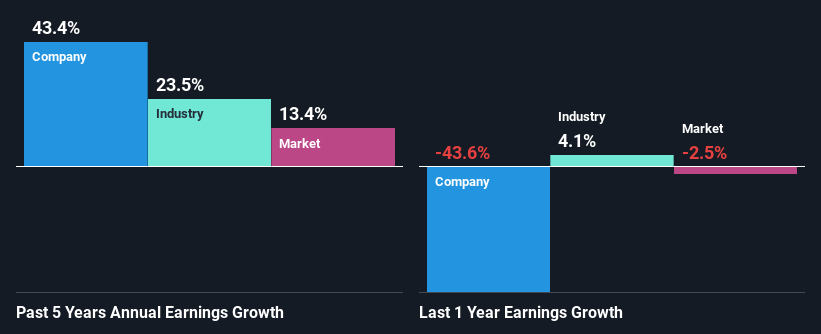Declining Stock and Solid Fundamentals: Is The Market Wrong About Boise Cascade Company (NYSE:BCC)?
With its stock down 11% over the past week, it is easy to disregard Boise Cascade (NYSE:BCC). However, a closer look at its sound financials might cause you to think again. Given that fundamentals usually drive long-term market outcomes, the company is worth looking at. In this article, we decided to focus on Boise Cascade's ROE.
ROE or return on equity is a useful tool to assess how effectively a company can generate returns on the investment it received from its shareholders. In short, ROE shows the profit each dollar generates with respect to its shareholder investments.
See our latest analysis for Boise Cascade
How Do You Calculate Return On Equity?
Return on equity can be calculated by using the formula:
Return on Equity = Net Profit (from continuing operations) ÷ Shareholders' Equity
So, based on the above formula, the ROE for Boise Cascade is:
22% = US$484m ÷ US$2.2b (Based on the trailing twelve months to December 2023).
The 'return' is the yearly profit. That means that for every $1 worth of shareholders' equity, the company generated $0.22 in profit.
Why Is ROE Important For Earnings Growth?
We have already established that ROE serves as an efficient profit-generating gauge for a company's future earnings. We now need to evaluate how much profit the company reinvests or "retains" for future growth which then gives us an idea about the growth potential of the company. Assuming everything else remains unchanged, the higher the ROE and profit retention, the higher the growth rate of a company compared to companies that don't necessarily bear these characteristics.
Boise Cascade's Earnings Growth And 22% ROE
To start with, Boise Cascade's ROE looks acceptable. Further, the company's ROE is similar to the industry average of 18%. Consequently, this likely laid the ground for the impressive net income growth of 43% seen over the past five years by Boise Cascade. We reckon that there could also be other factors at play here. For example, it is possible that the company's management has made some good strategic decisions, or that the company has a low payout ratio.
As a next step, we compared Boise Cascade's net income growth with the industry, and pleasingly, we found that the growth seen by the company is higher than the average industry growth of 24%.
Earnings growth is a huge factor in stock valuation. It’s important for an investor to know whether the market has priced in the company's expected earnings growth (or decline). By doing so, they will have an idea if the stock is headed into clear blue waters or if swampy waters await. Has the market priced in the future outlook for BCC? You can find out in our latest intrinsic value infographic research report.
Is Boise Cascade Making Efficient Use Of Its Profits?
Boise Cascade's ' three-year median payout ratio is on the lower side at 2.8% implying that it is retaining a higher percentage (97%) of its profits. So it looks like Boise Cascade is reinvesting profits heavily to grow its business, which shows in its earnings growth.
Moreover, Boise Cascade is determined to keep sharing its profits with shareholders which we infer from its long history of six years of paying a dividend. Our latest analyst data shows that the future payout ratio of the company is expected to rise to 41% over the next three years. Therefore, the expected rise in the payout ratio explains why the company's ROE is expected to decline to 17% over the same period.
Summary
On the whole, we feel that Boise Cascade's performance has been quite good. In particular, it's great to see that the company is investing heavily into its business and along with a high rate of return, that has resulted in a sizeable growth in its earnings. With that said, the latest industry analyst forecasts reveal that the company's earnings growth is expected to slow down. To know more about the latest analysts predictions for the company, check out this visualization of analyst forecasts for the company.
Have feedback on this article? Concerned about the content? Get in touch with us directly. Alternatively, email editorial-team (at) simplywallst.com.
This article by Simply Wall St is general in nature. We provide commentary based on historical data and analyst forecasts only using an unbiased methodology and our articles are not intended to be financial advice. It does not constitute a recommendation to buy or sell any stock, and does not take account of your objectives, or your financial situation. We aim to bring you long-term focused analysis driven by fundamental data. Note that our analysis may not factor in the latest price-sensitive company announcements or qualitative material. Simply Wall St has no position in any stocks mentioned.

 Yahoo Finance
Yahoo Finance 
